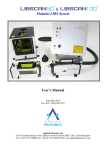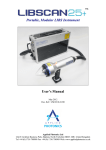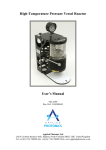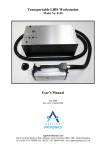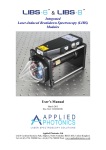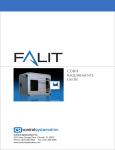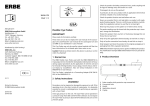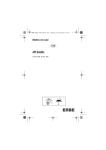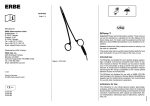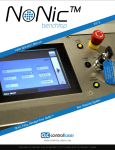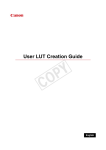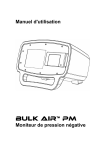Download User manual - Applied Photonics Ltd
Transcript
Modular LIBS System User’s Manual May 2015 Doc. Ref.: UM/0168-01/02 Applied Photonics Ltd Unit 8 Carleton Business Park, Skipton, North Yorkshire BD23 2DE, United Kingdom Tel +44 (0) 1756 708900 Fax +44 (0) 1756 708909 Web: www.appliedphotonics.co.uk Contents 1. Introduction Page 3 2. Safety 2.1 Laser radiation 2.2 Note on the laser safety window material used in the modular sample chambers 2.3 Electrical 3 3 6 6 3. General description 3.1 Overview 3.2 LIBSCAN 100 console 3.3 LIBSCAN head 3.4 Laser beam expander and plasma light collection optics 3.5 Modular Sample Chamber Connection 3.5.1 SC-2C modular sample chamber 3.5.2 SC-2L modular sample chamber 3.6 ICE 450 laser power supply 3.7 Imaging camera and associated components 7 7 7 8 10 11 11 12 13 14 4 Assembly of LIBSCAN system 15 5. Operating procedure 19 6. Shut-down procedure 20 7. Operating LIBSCAN in “open beam” configuration 21 8. Maintenance and inspection 21 9. Shipping and storage 21 10. Trouble-shooting / fault finding 22 Appendices A1 Modular sample chambers 23 A2 Example configurations of LIBSCAN system 27 A3 Certificate of Conformity 28 © 1998 - 2015 Applied Photonics Ltd Page 2 of 28 1 Introduction The LIBSCAN 100 Ultra is a modular design LIBS system which offers a highly versatile, adaptable and upgradeable product suitable for use either in a laboratory environment or in the field. The modular design is also particularly well-suited to research and development work and hence LIBSCAN will be of value to organisations who wish to conduct their own LIBS R&D program and who may wish, for example, to integrate LIBSCAN with an industrial process control application. LIBSCAN is currently available with a 100 mJ 1064 nm laser (LIBSCAN 100 ULTRA), although versions configured for alternative laser powers and wavelengths (e.g. 355 nm, 266 nm) and with double-pulse option are available as a special order. LIBSCAN is available with either six or eight plasma light collection channels and so therefore may be used with up to eight individual spectrometers. Various types of modular sample chamber are available for LIBSCAN including ones equipped with computer-controlled, multi-axis sample stages (see Appendix A2). This User’s Manual provides the necessary information needed to configure the integrated LIBSCAN system and how to use it safely. It is assumed that the user will be familiar with the safety issues arising from the use of high-power lasers and will have preferably been trained in the safe use of laser products. Ideally, your organisation will have an appointed Laser Safety Officer, in which case this person should be consulted before operating LIBSCAN. Examples of typical configurations of the LIBSCAN system, including illustrations of how it may be used with various sample chambers, are given in Appendix A2. 2 Safety 2.1 Laser radiation LIBSCAN contains a high-power Q-switched Nd:YAG laser (Class 4) and so it is imperative that it is operated only by suitably trained and experienced persons who are fully aware of the hazards inherent to this type of high-power laser equipment. It is imperative also that, prior to using the equipment, an appropriate risk assessment is conducted in such a way as to take account of the proposed use of the equipment, the environment in which the equipment is to be operated, and how its use may affect people who are not directly involved with the use of the equipment. LIBSCAN is designed to meet the laser safety requirements of the relevant European standards (BS EN 60825) and USA standards (ANSI Z136.1 – 2007). Although LIBSCAN may be supplied with a sample chamber which provides adequate containment of the laser radiation to Class 1 Accessible Emission Limits, it is possible for the user to operate LIBSCAN without the sample chamber (i.e. operation in “open beam” mode as may be required for certain types of experiment). Accordingly, it is necessary to consider LIBSCAN to be a Class 4 Laser Product and so, by definition, the equipment poses a risk of personal injury (eye, skin injury) and poses a fire risk. As with all Class 4 laser products, appropriate © 1998 - 2015 Applied Photonics Ltd Page 3 of 28 safety precautions must be taken as identified via a suitable risk assessment conducted by the user in consultation with a suitably qualified and experienced Laser Safety Officer. The most significant hazard relating to exposure of personnel to the laser radiation is eye injury since direct or scattered laser radiation produced by LIBSCAN can cause serious and permanent injury to the eyes including blindness - such injury may be instantaneous. Precautions must be taken to avoid exposure of personnel to hazardous levels of laser radiation. Such precautions may include the setting up of a temporary or permanent laser controlled area (e.g. a laser laboratory). Other measures may also be necessary, as determined by appropriate and thorough assessment of the risks (i.e. a risk assessment) conducted by the personnel responsible for the safe use of the LIBSCAN system. Consult the manual supplied with the laser for further guidance on the safe use of the laser. The door of the sample chamber is equipped with a dual electrical interlock switch which is designed to prevent activation of the laser unless the door is fully closed. The “Intlk In” and “Intlk Out” BNC connectors on the front panel of the LIBSCAN console connect with the “Intlk In” and “Intlk Out” BNC connectors on the front panel of the laser power supply using the two supplied BNC leads. Removal of the sample chamber from the LIBSCAN head will also activate the interlock (i.e. prevent activation of the laser). The key-switch operated Interlock Override (see section 3.2 of this User’s Manual) allows the safety interlock feature to be disabled. It is necessary to use this override feature when operating the LIBSCAN without a sample chamber (i.e. operating in “open beam” mode). In view of this, the LIBSCAN system must be categorised as a Class 4 laser product since, by design, the product may be used in such a way that the laser beam is not contained (i.e. “open beam” mode of operation). If, however, the sample chamber is correctly fitted to the LIBS module and the Interlock Override is switched off and the key removed, then the laser radiation is adequately contained to Class 1 Accessible Emission Limits by the design of the hardware. You should consult your Laser Safety Officer to ensure that this meets any local rules and regulations concerning the operation and use of Class 4 laser systems within your organisation. IMPORTANT • READ and UNDERSTAND both this User’s Manual and the instructions provided by the manufacturer of the laser before operating the LIBSCAN system. • NEVER allow unauthorised and/or untrained persons operate the LIBSCAN system. • Only suitably qualified and authorised persons should activate the Interlock Override keyswitch feature. The key MUST be removed from the Interlock Override keyswitch and held by a responsible person (e.g. your Laser Safety Officer) when this feature is not required. • ALWAYS use appropriate laser safety protective eyewear when operating the LIBSCAN system in “open-beam” configuration – you should seek advice from your Laser Safety Officer on this matter. • ALWAYS switch the laser off when not in use and remove the key from the keyswitch of the laser power supply to prevent unauthorised activation. • NEVER operate the LIBSCAN system in areas where explosive gas mixtures may be present. • NEVER operate the LIBSCAN system with any access cover, panel, or protective window removed. © 1998 - 2015 Applied Photonics Ltd Page 4 of 28 • NEVER place inside the sample chamber flammable liquids or any other material which may give rise to flammable / explosive gas mixtures. Activation of the laser under these conditions could result in an explosion leading to severe personal injury and/or fire hazard. Remember that the laser-induced plasma is a source of ignition. • ALWAYS thoroughly inspect the LIBSCAN system for damage prior to use. Particular attention should be given to the laser safety windows and the electrical safety interlock fitted to the door of the sample chamber. • NEVER point the LIBSCAN head at a person (even with laser switched off), especially towards the eyes, even if the person is wearing laser safety eyewear. The laser should be considered “active” unless the laser power supply is deactivated and the safety shutter located on the side of the LIBSCAN head is switched to the CLOSED position. • NOTE that the transparent acrylic nozzle aperture does not provide any protection to the user against exposure to direct or scattered laser radiation. The function of the nozzle aperture is described in Section 3.4. Acrylic nozzle aperture Laser aperture warning label Laser warning indicator light Laser safety shutter switch (Horizontal = OPEN, Vertical = CLOSED) Image of LIBSCAN head showing location of laser shutter switch, warning indicator light and laser aperture warning label © 1998 - 2015 Applied Photonics Ltd Page 5 of 28 2.2 Note on the laser safety window material used in the modular sample chambers The laser safety window material fitted to the modular sample chambers is rated as follows: Laser Wavelength (nm) 1064 355 266 USA Standard ANSI Z 136.1 UK & European Standard BS EN 207 Optical Density OD 6 OD 5 OD 3 Protection Level R (Q-switched laser) L6 L5 L3 R L6 at 1064 nm indicates a protection level of maximum spectral transmittance of 10-6 at 1064 nm for a pulsed laser of pulse length 10-9 – 10-7 seconds (i.e. a Q-switched laser). The laser safety windows used in Applied Photonics Ltd.’s range of modular sample chambers provide adequate protection against scattered laser light of wavelength 1064 nm, 355 nm and 266 nm such that Class 1 Accessible Emission Limits are met if the sample chamber is used correctly and laser pulse energies are not excessively high (i.e. typically less than 250 mJ with a 5 - 10 ns pulse length). Given that the modular sample chambers may be used with a variety of LIBSCAN system (and LIBS-6 and LIBS-8 integrated LIBS modules) configurations, it is the responsibility of the user to conduct a risk assessment to establish whether or not the laser safety windows provide adequate protection for the particular laser being used. If in any doubt, you should consult your Laser Safety Officer and/or Applied Photonics Ltd for advice on this matter. Warning – the Applied Photonics Ltd modular sample chambers are designed specifically for use with our LIBSCAN (and our LIBS-6 / LIBS-8 integrated LIBS modules) range of products and should not be used with any other laser device or product. If in doubt, seek advice from the manufacturer, Applied Photonics Ltd. 2.3 Electrical The LIBSCAN system contains electrical circuits operating at 12 VDC at a maximum current of 2.5 Amp. Accordingly, they pose no electric shock risk. The laser head (located inside the LIBSCAN head) and associated power supply, however, contain electrical circuits operating at potentially lethal voltage and current levels. Consult the manufacturer’s User Manual supplied with the laser for further guidance on the safe use of the laser. © 1998 - 2015 Applied Photonics Ltd Page 6 of 28 3 General description 3.1 Overview The main components of LIBSCAN 100 ULTRA (with SC-2L sample chamber fitted) are illustrated in the following figure. Flexible umbilical LIBSCAN 100 head Laser power supply (ICE 450) LIBSCAN 100 console SC-2L modular sample chamber Image showing LIBSCAN 100 with SC-2L sample chamber. The ICE 450 laser power supply is on the right. 3.2 LIBSCAN 100 console Spectrometer trigger input (connects to “Q-Switch Out” BNC port on laser power supply) Inert gas inlet port for gas-purge of sample (requires 4 mm OD plastic tubing) Interlock Override Keyswitch Interlock Override warning indicator LED External warning light (Output = 12 VDC, centre pin +ve). “Video Out” (phono connector) Interlock IN/OUT connects to Interlock IN/OUT on front of the ICE 450 laser power supply. See Section 4 “Power On” indicator light 12 Volt DC power input (<2.5 Amp) For connection to laboratory door switch, if required. Auxiliary 12 Volt DC power output USB 2.0 connection for external computer Main fuse (3 Amp) Close-up view of the LIBSCAN 100 console front panel © 1998 - 2015 Applied Photonics Ltd Page 7 of 28 The LIBSCAN 100 console contains the optical spectrometers (up to six or eight spectrometers may be installed, depending on the model of LIBSCAN system) and electrical circuits for the laser safety interlock. The console requires a 12 Volt DC electrical supply (2.5 Amps max.) which is derived from the mains electrical supply using the low-voltage adaptor (12 VDC, 2.5 Amps) supplied with LIBSCAN 100. The Interlock Override key is used to override the laser safety interlock when the LIBSCAN system is required to be used in “open beam” configuration (i.e. without a sample chamber). To override the interlock, the keyswitch should be turned “on” by turning clock-wise. The Class 4 Warning LED will flash continuously when the keyswitch is activated and the laser is in “active” mode. When the keyswitch is set to “off”, the Class 4 Warning LED will be extinguished indicating that the laser safety interlock is operating. The key should be removed from the Interlock Override to prevent unauthorised activation of the interlock override. It is important to be aware that when a sample chamber is used and the Interlock Override key is activated, the laser may be activated when the sample chamber door is open. So the user must treat the LIBSCAN 100 equipment as a Class 4 laser product whenever the Interlock Override key is activated, regardless of whether a sample chamber is fitted or not. 3.3 LIBSCAN head The LIBSCAN head contains the laser and associated optics required to focus the laser beam on to a sample and collect the plasma light for transmission to the spectrometers located within the LIBSCAN 100 console. Two versions are available – 6-channel and 8-channel. The 6-channel version is illustrated throughout this User’s Manual. The head is designed to accommodate a miniature CCD camera and associated components used with the optional imaging kit. The main features of the LIBSCAN head fitted with the optional imaging kit are illustrated in the following figures. Use of the transparent aperture nozzle allows the operator to view the laser plasma even when a sample is placed up against the aperture. WARNING: Note that the transparent aperture nozzle does NOT provide any protection to the user against exposure to the laser radiation. It is not necessary to have an aperture nozzle fitted to the LIBSCAN 100 head although it is beneficial to do so as it provides the following functions: i) facilitates correct positioning of the sample being analysed, ii) helps to direct the purge gas (if used) to the region in space where the laser plasma will be formed, and iii) provides protection for the optics etc. against accidental mechanical damage. LIBSCAN 100 head with aperture nozzle removed © 1998 - 2015 Applied Photonics Ltd LIBSCAN 100 head with aperture nozzle fitted Page 8 of 28 Laser warning indicator light Grub screw for locking aperture nozzle (do not over-tighten) Miniature CCD camera (optional feature) Array of high-brightness white LED lights (for use with imaging kit if fitted) Electrical connection to sample chamber Circular array of six lens holders – used to collect plasma light. The purple lens holder is for collection of deep UV, the blue lens holders for UV-VIS and the red lens holders are for collection of VIS-NIR. Transparent aperture nozzle Laser beam output aperture Gas purge outlet Front view of LIBSCAN 100 head (6-channel version) showing plasma light collection lens array, CCD camera, LED lights, laser aperture and gas purge outlet Electrical connections to laser head Water connections to laser head “Video Out” electrical connection for imaging camera Dimmer control for LED lights Rear view of LIBSCAN 100 head showing electrical / water connections to laser head and electrical connection for the camera © 1998 - 2015 Applied Photonics Ltd Page 9 of 28 3.4 Laser beam expander and plasma light collection optics The optical configuration used in the LIBSCAN 100 system is illustrated schematically in the following diagram. The laser beam expander consists of three lenses and is used to provide a tightly focussed laser beam at nominally 80 mm from the aperture of the beam expander (90 mm for the 8-channel LIBSCAN 100). The brass tubular piece which houses the beam expander lenses is threaded so that rotating it causes the focal plane of the laser beam to move. A special tool is used to rotate the brass tubular piece after first removing the nozzle aperture for access. The design allows for approximately ±7.5 mm of adjustment, as illustrated in the following diagrams. The plasma light collection optics are angled at approx. 17.4 degrees (15.7 degrees for the 8-channel LIBSCAN) and are designed to collect light from the region in space defined in the following diagram. The transparent aperture nozzle is threaded so that rotation causes it to move along the optic axis of the laser beam – range of travel is approximately ±7.5 mm (it may be removed from the body of the LIBS module by unscrewing further). The main purpose of the transparent aperture nozzle is to provide a convenient means of setting the distance to the sample surface. The nozzle aperture also provides containment of the purge gas to ensure the sample surface and laser-induced plasma region are effectively purged of atmospheric air, and provides physical protection for the laser and plasma light collection optics (and imaging camera if fitted). Transparent aperture nozzle Adjustment range of transparent aperture nozzle (approx. ±7.5 mm) Brass holder containing laser beam expander lenses Laser Beam Laser Beam Threaded section Fibre-optic cable to spectrometer Adjustment range of focal plane of laser beam (approx. ±7.5 mm) Threaded section ±7.5 mm Laser Beam ±7.5 mm Close-up view of laser beam focus and field-of-view of plasma light collection optics © 1998 - 2015 Applied Photonics Ltd Page 10 of 28 3.5 Modular Sample Chamber Connection 3.5.1 SC-2C modular sample chamber The SC-2C modular sample chamber is designed to fit to the LIBSCAN 100 head using four M5 screws as illustrated in the following figures. Before fitting the sample chamber to the LIBSCAN 100 head, ensure that the breadboard plate is positioned sufficiently low so as not to make contact with the aperture nozzle of the LIBSCAN head (use the y-axis adjustment knob to lower the breadboard plate). Be careful to fit the sample chamber squarely to the LIBSCAN 100 head so as not to cause damage to the electrical connectors. Secure SC-2C sample chamber to LIBSCAN 100 head using the four M5 cap head screws CAD views of SC-2C modular sample chamber illustrating method of attachment to LIBSCAN 100 head CAD views of SC-2C modular sample chamber attached to LIBSCAN 100 head © 1998 - 2015 Applied Photonics Ltd Page 11 of 28 3.5.2 SC-2L modular sample chamber The LIBSCAN 100 head is designed to fit to the top of the sample chamber using four M5 screws as illustrated in the following figures (accessed from inside the SC-2L sample chamber). Before fitting the LIBSCAN 100 head to the sample chamber, ensure that the breadboard plate is positioned sufficiently low so as not to make contact with the aperture nozzle of the LIBSCAN 100 head. Be careful to fit the LIBSCAN 100 head squarely to the sample chamber so as not to cause damage to the electrical connectors. Secure LIBSCAN head to SC-2L sample chamber using the four M5 cap head screws CAD view of SC-2L modular sample chamber illustrating method of attachment of LIBSCAN head LIBSCAN 100 head SC-2L modular sample chamber Breadboard plate (where sample is located) Gooseneck LED light CAD view of LIBSCAN 100 head fitted to SC-2L modular sample chamber © 1998 - 2015 Applied Photonics Ltd Page 12 of 28 3.6 ICE 450 laser power supply See Quantel’s instructions for a complete description of the ICE 450 laser power supply and cooling group unit. Mains power lead Interlock OUT BNC port Interlock IN BNC port Q-Switch OUT BNC port External I/O D-Sub type port Water line connections BNC clamping piece (used to prevent unauthorised disconnection of laser safety interlock BNC connectors) RS232 serial port (labelled IOIOI) Schematic diagram illustrating ICE 450 laser power supply © 1998 - 2015 Applied Photonics Ltd Page 13 of 28 3.7 Imaging camera and associated components The imaging camera is offered as an optional feature for LIBSCAN 100. A miniature colour CCD camera is installed inside the LIBSCAN 100 head and is located within the black tubular holder at the 12 O’clock position at the front of the head (illustrated below). The tubular holder is fitted with an optical filter to protect the CCD camera from damage due to possible high levels of stray laser light (1064 nm). The electrical connections to the camera are accessible at the rear of the LIBSCAN 100 head and video images may be fed to a computer via the USB frame grabber supplied with the imaging kit. Viewing angle of miniature CCD camera relative to laser beam Laser beam Image of LIBSCAN 100 head showing viewing angle of miniature CCD camera The specifications for the miniature CCD camera are: • • • • 1/3-inch CCD colour sensor (473,000 pixels) Micro f = 12 mm, 24-degree field of view Adjustable focus (approx. 20 mm to infinity) 12 VDC (65 mA) © 1998 - 2015 Applied Photonics Ltd Page 14 of 28 4 Assembly of LIBSCAN 100 system Step 1 LIBSCAN 100 should first be checked for obvious signs of damage, loose fixings, etc. prior to use. If any of the components of the instrument are found to be of suspect condition, take remedial action before assembling and using the instrument. Of particular importance are the safety critical components such as the laser safety windows and electrical interlock circuits of the sample chamber. Seek advice from the manufacturer if necessary. Do not operate LIBSCAN 100 with any of the covers or windows removed. Step 2 Prior to connecting the laser power supply, personal computer (etc.); the LIBSCAN 100 head should first be placed on a suitable surface such as a laboratory bench or optical table. It is highly desirable to secure the LIBSCAN 100 head in some way (e.g. by utilizing the feet attached to the base of the LIBSCAN head and which are designed to suit a metric or imperial optical table) to prevent accidental dropping of the head resulting in possible damage to the sensitive components inside. Step 3 If the sample chamber is to be used, fit the LIBSCAN 100 head to the sample chamber using the four M5 screws (supplied with the unit) as illustrated in the previous figures. Schematic diagram illustrating connections between LIBSCAN 100 components © 1998 - 2015 Applied Photonics Ltd Page 15 of 28 Step 4 Connect the coolant pipes and electrical cables (supplied with the laser) between the LIBS head and the ICE 450 laser power supply. Step 5 water. Follow Quantel’s instructions for filling the ICE 450 laser power supply with coolant Phono connection to PC for imaging CCD camera Electrical connections to External I/O D-Sub type port on ICE 450 PSU Water cooling line connections Mains power lead External I/O D-Sub type port Rear view of LIBSCAN 100 head showing electrical / water connections to ICE 450 PSU and Video Out connection to PC, for the CCD camera Step 6 console. Connect the 12 Volt DC (2.5 Amp) plug-in mains power adaptor to the LIBSCAN 100 Step 7 Using the supplied BNC cables, connect the INTLK OUT connector on the LIBSCAN 100 console to the INTLK OUT connector on the ICE 450 laser power supply. Do likewise for the INTLK IN connections. Note that the connections should be made as follows – INTLK IN to INTLK IN and INTLK OUT to INTLK OUT. Step 6 Using the supplied BNC-to-BNC cable, connect the “Trigger In” port on the LIBSCAN 100 console to the “Q-Switch Out” port on the front of the laser power supply. Step 7 Connect the personal computer to the “Computer I/O” port of the LIBSCAN 100 console using the supplied USB 2.0 cable. Step 8 Connect the personal computer to the serial port on the front panel of the ICE 450 laser power supply using the supplied Serial-to-Serial lead. If the personal computer is not equipped with a serial port, it will be necessary to use a Serial-to-USB converter (note that this device usually requires the installation of a software driver on the personal computer – refer to instructions written on the CD:ROM supplied with the Serial-to-USB converter lead). © 1998 - 2015 Applied Photonics Ltd Page 16 of 28 Interlock OUT connects to Interlock OUT on front of the ICE 450 laser power supply Spectrometer trigger input connects to “Q-Switch Out” BNC port on laser power supply Interlock IN connects to Interlock IN on front of the ICE 450 laser power supply 12 Volt DC power input (<2.5 Amp) USB 2.0 connection for external computer Close-up view of the LIBSCAN 100 console front panel Interlock Out Q-Switch Out Interlock In RS232 Serial Port (IOIOI) Front view of ICE 450 PSU showing Q-Switch and interlock connections to the LIBSCAN 100 console and serial port (IOIOI) connection to PC Step 9 If there is a need to use an external laser warning light (e.g. located at the entrance door to a laser laboratory), this should be connected to the “Warning Light” port on the LIBSCAN 100 console. . The “Warning Light” port provides a 12 VDC (1 Amp max., centre pin +ve) voltage when the laser is in an active state. Step 10 If the gas-purge feature is to be used, connect a suitable inert gas supply (Argon, Helium, Nitrogen, Air) to the “Inert Gas Supply” port using 4 mm OD flexible tubing (a length of this type of tubing is supplied with the LIBSCAN 100 – coloured green). WARNING - the gas supply MUST be externally regulated to restrict pressure to less than 5 psi (2 to 3 psi should be adequate) and to control the flow-rate. DO NOT USE FLAMMABLE GASES! © 1998 - 2015 Applied Photonics Ltd Page 17 of 28 The following image illustrate how the LIBSCAN 100 system should look after final assembly. Images of LIBSCAN 100 system with SC-2L sample chamber and desktop PC after final assembly © 1998 - 2015 Applied Photonics Ltd Page 18 of 28 5 Operating procedure Step 1 Open laser safety shutter (located on LHS side panel of LIBSCAN 100 head) by turning handle to horizontal position. Step 2 Activate laser by switching on key switch (see instructions supplied with laser). Step 3 With the laser switched on (coolant water flowing, but laser flashlamp not yet activated), check for correct operation of the safety interlock by observing the “Class 4 Warning” light on the front panel of the LIBSCAN 100 console and opening / closing the door of the sample chamber (with LIBSCAN 100 head fitted and all interlock cables correctly fitted). If the interlock is working correctly, the “Class 4 Warning” light should flash when the sample chamber lid is open and be constantly illuminated when the lid is closed. If the interlock is found not to be operating correctly, refer to the Fault Finding section of this User’s Manual. Note that if the LIBSCAN 100 head is removed from the sample chamber, the interlock circuit is designed to de-activate the laser (see section 6 on Operating instrument in “open-beam” configuration). Warning – do not operate LIBSCAN 100 if the safety interlock is not functioning correctly. Step 4 Place a sample of material (e.g. a metal block) at the focal plane of the Nd:YAG laser beam inside the sample chamber. Close the door of the sample chamber. Using the controls on the Remote Box of the ICE 450 laser power supply (see following figure and refer to laser manufacturer’s instructions), the laser beam may now be fired by i) first activating the flashlamp and ii) then activating the Q-Switch. If the sample material is located at or near to the focal plane of the laser beam, a laserinduced plasma will be produced on the surface of the sample. It may be necessary to adjust the position of the aperture nozzle to obtain correct positioning of the sample surface (see figure below). Step 5 Follow the instructions provided with the LIBSoft software to correctly configure the spectrometers and the laser for acquiring data. Please refer to the LIBSoft Software User Manual for further information regarding the acquisition of spectra. Note that the laser Remote Box should not be used while LIBSoft is running as this will result in the laser reverting to manual control. To resume LIBSoft software control of the laser, it will be necessary to switch off the laser and close LIBSoft, then switch on the laser followed by re-starting LIBSoft. Fault warning light View of front panel of laser power supply controller (referred to as Remote Box in Quantel’s documentation) © 1998 - 2015 Applied Photonics Ltd Page 19 of 28 Distance may be adjusted by several mm by rotating the aperture nozzle. Use this feature to set position of aperture nozzle to facilitate correct positioning of sample surface Locking screw. Do not over tighten CAD view of LIBSCAN 100 head showing method for adjusting position of aperture nozzle Step 6 Adjustment of the laser output energy is achieved by adjusting the Flashlamp-to-Q-Switch (FL-QS) delay time. When running the laser in manual mode, the FL-QS delay time may be adjusted via the Remote Box (refer to Quantel’s instructions for the laser). The factory setting is typically around 140 microseconds for maximum laser output energy, although this will vary from laser to laser. Increasing the FL-QS delay will reduce the laser output energy. The user will only be able to adjust the FL-QS delay setting from the minimum factory setting (typically 140 microseconds) up to 500 microseconds, although the laser output energy will likely be approaching zero with a FL-QS delay setting of approx. 400 microseconds. When running the laser via LIBSoft, the laser energy may be adjusted in a similar fashion but by entering an appropriate FL-QS delay time via LIBSoft rather than the Remote Box. Step 7 After successfully testing LIBSCAN 100, it is now ready for use. Measurement conditions such as Nd:YAG laser pulse energy and position of sample surface with respect to laser beam focal plane will need to be adjusted to suit the requirements of the experiment. 6 Shut-down procedure Step 1 Shut down LIBSoft software (if being used) and then switch off laser power supply and isolate from mains electrical supply. Step 2 Close the laser safety shutter on the LIBSCAN 100 head by turning the handle (located on LHS side panel of LIBSCAN 100 head) to vertical position. Step 3 Isolate 12 Volt DC plug-in power adaptor from mains electrical supply and disconnect from LIBSCAN 100 console. Step 4 Disconnect gas supply if connected. © 1998 - 2015 Applied Photonics Ltd Page 20 of 28 7 Operating LIBSCAN 100 in “open beam” configuration Warning Class 4 Laser Product. Only suitably trained and experienced persons under the supervision of a duly appointed Laser Safety Officer should operate LIBSCAN 100 in “open beam” configuration. LIBSCAN 100 may be used without the sample chamber if required. Under these conditions, the laser beam is not contained (i.e. the equipment is a Class 4 laser product) and hence additional safety precautions must be observed including the use of appropriate laser protective eyewear and operating LIBSCAN in a suitable controlled environment (e.g. a laser laboratory). Important - it is the responsibility of the user to conduct an appropriate risk assessment prior to using LIBSCAN 100 in open-beam mode. If the sample chamber is not fitted to the LIBSCAN 100 head, it will be necessary to activate the Interlock Override by turning the key switch to the “ON” position (i.e. turn clockwise). The two LED warning lights will commence flashing (assuming the laser is in an active state). WARNING: As outlined in Section 2.1, activating the Interlock Override will disable the sample chamber safety interlock feature and allow the LIBSCAN 100 head to emit potentially hazardous levels of laser radiation (i.e. Class 4 laser product). It is the responsibility of the user to ensure that safety is maintained when operating LIBSCAN 100 in this configuration. As a minimum, it will be necessary to operate LIBSCAN 100 in a laser controlled area (e.g. a laser laboratory) and for all personnel in the controlled area to wear appropriate laser protective eyewear. Consult your Laser Safety Officer before operating LIBSCAN 100 in this mode. 8 Maintenance and inspection LIBSCAN 100 should be periodically inspected for signs of damage or wear and tear. Of particular importance are the safety features including the laser safety windows and the laser safety interlock mechanisms and associated electrical circuits. If any damage to the laser safety windows is observed or suspected, or the sample chamber door interlock switch is not functioning correctly, LIBSCAN 100 should be temporarily removed from service until the fault is rectified. For maintaining and inspecting the Quantel Big Sky laser, the documentation supplied with the laser should be consulted. If in any doubt, contact the manufacturer, Applied Photonics Ltd, for further advice on maintenance and inspection of the product. 9 Shipping and storage The LIBSCAN 100 system should be kept in a clean, dry environment which is free from extremes of temperature. The equipment contains sensitive optical and electro-optical components and so should be protected from excessive vibration or shock. During transport, the LIBSCAN 100 system and associated components should be packed in such a way as to prevent damage from shock or vibration and protected from ingress of dust. For shipping or storage of the laser, refer to the laser manufacturer’s instructions for the correct procedure. The laser power supply and laser head (within the LIBSCAN 100 head) MUST be drained of coolant water if there is any possibility of the unit being exposed to temperatures below 4 Celsius (e.g. during transit). Failure to do so could result in serious damage to the laser head and/or the laser power supply. The laser manufacturer’s instructions should be followed for draining coolant water from the laser power supply and the laser head. © 1998 - 2015 Applied Photonics Ltd Page 21 of 28 10 Trouble-shooting / fault finding Laser does not activate: 1. Is the laser shutter on the LIBSCAN 100 head set to the OPEN position? 2. Is the safety interlock connected correctly? 3. Is the “Class 4 Warning” indicator light on laser power supply controller flashing? If yes, then check that sample chamber door is fully closed. If a sample chamber is not fitted to the LIBSCAN 100 head and the equipment is required to be operated in “open-beam” (i.e. Class 4 Laser Product) mode, then the Interlock Override will need to be activated. 4. If the safety interlock appears to be working correctly but the laser still does not activate, refer to the operating instructions provided with the laser. Laser-induced plasma appears to be adequately intense although a poor signal is observed on some or all of the spectrometer channels: 1. Are the data acquisition settings on the LIBSoft software set up correctly? 2. Is the composition of the sample such that emission lines are not expected to be seen on some or all of the spectrometer channels? If yes, then use an alternative sample which has numerous emission lines (e.g. an iron-containing material such as steel) to check for correct operation of the LIBSCAN 100 system. 3. Is the sample positioned correctly relative to the laser beam focus? It may be necessary to adjust the position of the aperture nozzle. 4. Is the laser pulse energy too low? Increase if necessary. Recorded spectra show some emission lines which are saturating the detector (“flat top” appearance to the emission line): 1. Reduce the pulse energy of the laser using the controls on the front panel of the laser power supply (manual mode of operation) or via the LIBSoft software (software control mode of operation). 2. Increase spot size of laser beam on sample by adjusting the position of the sample relative to the focal plane of the laser beam. Recorded spectra show some emission lines suffering from “self-reversal” (i.e. a “dip” in the centre of the emission line): 1. Reduce the pulse energy of the laser. 2. Increase spot size of laser beam on sample by adjusting the position of the sample surface relative to the focal plane of the laser beam (it is usual to set focus to be approximately 1 to 3 millimetres “into” the sample surface) Air-breakdown is observed in the path of the laser beam just in front of the sample surface: 1. The focal plane of the laser beam is set incorrectly (i.e. it is set to be in front of the sample) – adjust position of sample so that the focal plane of the laser beam is coincident, or preferably just “into”, the sample surface. 2. On irradiation by the laser beam, the sample is creating considerable quantities of particulates in the path of the laser beam. Try cleaning the surface of the sample if loose material (e.g. oxide, surface contamination etc.) is present. Reducing the laser energy and/or increasing laser beam spot size on the surface of the sample may also help. © 1998 - 2015 Applied Photonics Ltd Page 22 of 28 Appendices Appendix A1 Modular sample chambers A range of modular sample chambers is available for use with the LIBSCAN 100 system (see table below). These sample chambers are also suitable for use with our LIBS-6 and LIBS-8 integrated LIBS modules. Two types (SC-2C and SC-2L) are described in more detail in the remainder of this User’s Manual. SC-1 SC-2C SC-2M SC-2L Single axis translation stage, 20 mm travel per stage (manual control). 2-axis translation stage, 20 mm travel per stage (manual control). 2-axis translation stage, 20 mm travel per stage (manual control) Fume extract port. Internal LED light. Approx. overall dimensions: 170 x 170 x 270 mm 3-axis translation stage, 50 mm travel per stage (manual control). Fume extract port. Internal LED light. Approx. overall dimensions: 260 x 260 x 320 mm Approx. overall dimensions: 110 x 120 x 200 mm Approx. overall dimensions: 110 x 120 x 250 mm SC-2XL XYZ-750 3-axis translation stage, 50 mm travel per stage (manual control). Fume extract port. Internal LED light. Approx. overall dimensions: 475 x 370 x 450 mm SC-LQ1 3-axis translation stage, 50 mm travel per stage (XY computercontrolled). Fume extract port. Internal LED light. Approx. overall dimensions: To Be Advised. Modular sample chamber designed to analyse liquids. Requires inert gas and flow of liquid to be connected to chamber via two ports designed to accept 4 mm flexible tubing. Liquid drain port in base of chamber. Micrometre control of position of liquid surface relative to focal plane of laser beam. Approx. overall dimensions: 225 x 245 x 200 mm Current range of modular sample chambers manufactured by Applied Photonics Ltd WARNING The modular sample chambers described above are designed specifically for use with our LIBSCAN range of modular LIBS systems and our LIBS-6 / LIBS-8 integrated LIBS modules. The specifications for the laser safety windows are as follows: Laser Wavelength (nm) 1064 355 266 USA Standard ANSI Z 136.1 UK & European Standard BS EN 207 Optical Density OD 6 OD 5 OD 3 Protection Level R (Q-switched laser) L6 L5 L3 Protection Level R L6 at 1064 nm indicates a protection level of maximum spectral transmittance of 10-6 at 1064 nm for a pulsed laser of pulse length 10-9 – 10-7 seconds (i.e. a Q-switched laser). Since the LIBS-6 / LIBS-8 integrated LIBS modules may be used with various laser devices, it is the responsibility of the user to establish whether the protection offered by the laser safety windows is © 1998 - 2015 Applied Photonics Ltd Page 23 of 28 adequate for the laser being used. If in doubt, seek advice from a suitably qualified Laser Safety Officer or contact Applied Photonics Ltd before operating the laser equipment. A general view of the SC-2C modular sample chamber is given in the following figure. The sample chamber is equipped with a breadboard plate which is attached to a manual two-axis translation stage (approx. 20 mm travel per stage). The breadboard plate has an array of M6 tapped (blind) holes on 25 mm centres and which may be used to facilitate the attachment of a sample holder etc. Movement of the breadboard is achieved by adjustment of the knobs on the side and top of the sample chamber, as illustrated below. Door with magnetic catch and dual electrical interlocks Electrical connection to LIBSCAN head Laser safety window Adjustment knob for y-axis translation stage Attachment screws for fitting sample chamber to LIBSCAN head Adjustment knob for x-axis translation stage Breadboard plate (with array of M6 tapped holes on 25 mm centres) CAD views of SC-2C modular sample chamber © 1998 - 2015 Applied Photonics Ltd Page 24 of 28 A general view of the SC-2L modular sample chamber is given in the following figure. The sample chamber is equipped with a breadboard plate which is attached to a manual three-axis translation stage (50 mm travel per stage). The breadboard plate has an array of M6 tapped (blind) holes on 25 mm centres and which may be used to facilitate the attachment of a sample holder etc. Movement of the breadboard is achieved by adjustment of the knobs on the sides and top of the sample chamber, as illustrated below. Adjustment knob for z-axis translation stage Laser safety window Door with magnetic catch and dual electrical interlocks Adjustment knob for y-axis translation stage Adjustment knob for x-axis translation stage View of SC-2L modular sample chamber Fume extract nozzle Gooseneck LED light Laser plasma Sample Breadboard plate (with array of M6 tapped holes on 25 mm centres) Inside of SC-2L sample chamber with LIBSCAN 100 head fitted and showing a laser-induced plasma on a metallic target © 1998 - 2015 Applied Photonics Ltd Page 25 of 28 The sample chamber is equipped with a number of features as illustrated in the following figures. Z-axis adjustment knob Fume extract nozzle Gooseneck LED light Breadboard plate (with array of M6 tapped holes on 25 mm centres) Electrical door interlock switch Magnetic catch for door Electrical door interlock switch X-axis adjustment knob Y-axis adjustment knob Feet suitable for attachment to a metric or imperial optical table Fume extraction port – for optional connection to an external air extraction unit (1/2” BSPP thread) Label for laser safety windows CAD views of the front and rear panels of SC-2L modular sample chamber © 1998 - 2015 Applied Photonics Ltd Page 26 of 28 Appendix A2 Example configurations of LIBSCAN 100 system © 1998 - 2015 Applied Photonics Ltd Page 27 of 28 Appendix A3 Certificate of Conformity Applied Photonics Limited Unit 8 Carleton Business Park EC Skipton North Yorkshire BD23 2DE United Kingdom Declaration of Conformity Applied Photonics Ltd declares that the product listed below has been designed and manufactured in compliance with the relevant standards as follows: Product name: LIBSCAN Modular LIBS System Model Number: LIBSCAN 100 ULTRA Laser product safety This device conforms to the principal objectives of safety of laser products by application of the following standards: PD IEC TR 60825-14:2004 and BS EN 207:1999 Electrical Safety This device conforms with the principal safety objectives of the European Directive 73/23/EEC, as implemented by the Electrical Equipment (Safety) Regulations 1994, by application of the following standard: BS EN 61010-1:2001. Electro-Magnetic Compatibility This device conforms with the principal objectives of the European Directive (89/336/EEC) as amended by 91/31/EEC and 93/68/EEC, as implemented by The EMC Regulations (SI 1992 No. 2372 and amendment SI 1994 No. 3080), by application of the following standard: BS EN 61326-1:2006 Year of affixation of the CE Marking: 2015 Signed: Name: Andrew I. Whitehouse Title: Managing Director Place: Applied Photonics Ltd, Unit 8 Carleton Business Park, Skipton, North Yorkshire, BD23 2DE, United Kingdom Date: March 2015 © 1998 - 2015 Applied Photonics Ltd Page 28 of 28




























